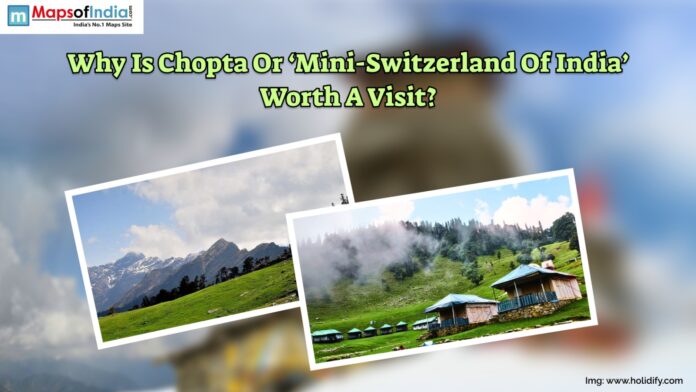Nestled in the folds of Uttarakhand’s Himalayas and sluggishly approached by mainstream travellers, the region still feels like one of India’s best-kept secrets. Despite being called the “Mini-Switzerland of India,” Chopta remains an out-of-the-way or offbeat destination different from any crow-appointed hill stations in the country. This paradise can be labelled as the alternative hill monkey to the more famous station in the country; it has rolling meadows, high mountain peaks, and the richest forest in the country. Hence, it makes worth a visit.
A Jem Connected with the Culture Called Garhwal Himalayas
Chopta is languidly waist high in the Garhwal Himalayas at about 2,700 meters, as it is a part of the Rudraprayag district in Uttarakhand state; unlike its renowned contenders, it still retains the pristine quality of Chopta despite its lack of attention by tourists. Therefore, the journey leading to this alpine getaway is the most interesting, with winding roads piercing through dense rhododendron jungles and tiny Himalayan villages.
The rich flora and fauna, comprising rare species and a limited number of humans, form Chopta’s wild nature. Without any commercial establishments or city infrastructure, this place provides an authentic natural environment that is hardly possible today.
The Time of Changing Landscapes
Indeed, the most astounding thing about being born and transformed into a new season is the temperature. During Summer, the ambient temperature is generally between 15°C and 20°C, providing an appropriate chill from the hostile plains below.
Usually, the onset of the monsoon brings to life the massive heaven-like clouds strung over the never-ending green mountain ranges. But the scene holds, being winter, for Chopta is almost entirely snow-clad from December to February, creating something like a winter wonderland seen among all that is seen in the European Alps. The sky’s wintery blue will do nothing but make the peaks shine even more, something perfect for souvenirs, no matter if one attends after or before December.
The Crown Jewel: Tungnath and Chandrashila
It would be unjust to speak about Chopta without mentioning Tungnath, the tallest Shiva temple in the universe and the third among the very holy Pentad Kedarnath. For 3.5 kilometres, the trail flicks beads of sweat in awe of gorgeous forests and lush meadows. All along the way, the mighty range of the Himalayas is the observer.
For those who savour the challenge, the trail leads further uphill to Chandrashila’s top, pinned flashing at 4,000 m or 4k. It receives a signature view of top Himalayan peaks, including Nanda Devi, Trishul, and Chaukhamba. In contrast, Chandrashila sunrise tends to be a spiritual experience as some first golden rays illuminate the caps of the snowy peaks. Everything looks like a divine spectacle.
The Cultural Folkloric City for the Fans of Flora and Fauna
The fauna and flora lovers have been catered for in Chopta. A constituent of the Kedarnath Wildlife Sanctuary is where you find several animal species endemic to the Himalayas. This would include musk deer, Himalayan black bear, and the endangered snow leopard. The bird songs saturate the jungle with approximately 240 species of precious birds, like those from the Himalayan monal, the state bird of Uttarakhand.
Towards the end of the mountains of Chopta is this beast called ‘Bugyals’, which are nature treasuries flaunting, worth its medicinal herbs and alpine wildflowers. The populated biking and trekking trends attract many tourists to Chopta. In this beyond-beautiful location, you can camp and spend the nights under the star-studded sky in Rohini Bugyal of Chopta.
Chopta to the Left at the Crossroads of Mountains
The grace of Chopta touches and fills not only one but the contiguous regions. The misty Deoria Tal, a lake that participates in a shimmering reflection of the legendary Chaukhamba, is just 31 km up there. As it is depicted in ancient folklore, this place is where Pandavas were asked questions by the Yaksa before being narrated in the Mahabharata. Karola Lake also has beautiful surroundings, which always attract nature lovers; it’s just 12 km away.
Ukhimath, situated 12 km east of Karola Lake, is also the winter home for Kedarnath. In the closing winter months, the valley where the Kedarkhanta temple is often locked with the worship switched to Ukhimath. At the narrow avenue in the Himalayas, the shy but peaceful hamlet offers a glimpse of local traditions as they are, of religious practices preserved ceaselessly since time immemorial.
The Simple Life of the Natives
This is the special element that accords Chopta with its exclusive meaning. The native villagers, most of whom are from the Garhwali tribal group, retain their age-old traditions in the face of the growing presence of the tourism industry. Providing a scarce experience among commercial tourist destinations, it is the combination of a good Garhwali meal, served at their generous homestays, which emboldens them to let their guests immerse themselves into the cultural fabric of the area.
Our most loyal followers living in this place are nature, who whisper the enduring message of how simplicity can genuinely be the source of all contentment day after day. Local festivals, especially those during the Baisakh (April-May) celebrations, offer candid glimpses into native cultures, music, and dancing that were probably handed down through the ages.
Ethically Responsible Business Practices
While choruses of the beauty of Chopta rise, the questions around sustainable tourism become louder. The region’s ecosystem might be fragile, and such a limit without proper management may destroy the points that make it charming. The local government has initiated waste management systems and regulated regulations to maintain the ecological balance.
Moreover, tourists themselves must own up to their responsibilities by following the “leave no trace” guidelines, adopting traditional practices, and earning profits from small-scale community-based tourism rather than big commercial companies.
A Break in the Clouds Before Rains Come
In a way, Chopta is currently standing in a perplexing place. It is over-discovered but not so commercialised that you must litter with litter bins at every corner. The place itself feels calm and not ruined or devastated. This equilibrium mechanism may not be sustained for long, considering the large influx of visitors as the number of offbeat destinations frequented by Indians continues to grow.




